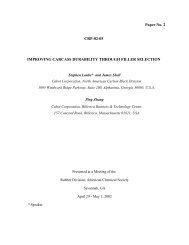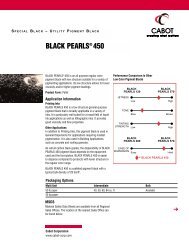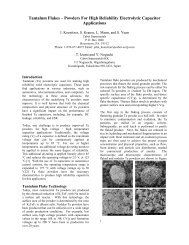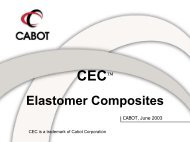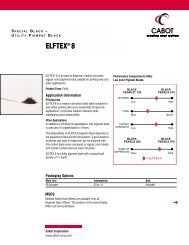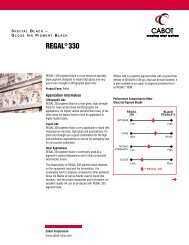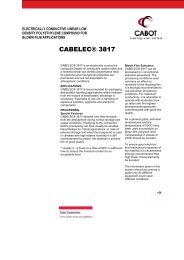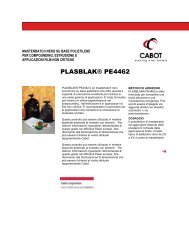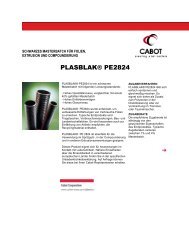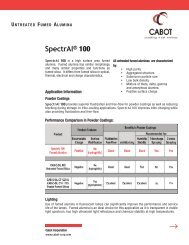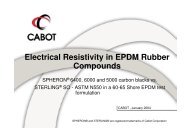Effect of Functionalization of Carbon Black on Rubber Properties
Effect of Functionalization of Carbon Black on Rubber Properties
Effect of Functionalization of Carbon Black on Rubber Properties
Create successful ePaper yourself
Turn your PDF publications into a flip-book with our unique Google optimized e-Paper software.
<str<strong>on</strong>g>Effect</str<strong>on</strong>g> <str<strong>on</strong>g>of</str<strong>on</strong>g> <str<strong>on</strong>g>Functi<strong>on</strong>alizati<strong>on</strong></str<strong>on</strong>g> <str<strong>on</strong>g>of</str<strong>on</strong>g> <str<strong>on</strong>g>Carb<strong>on</strong></str<strong>on</strong>g> <str<strong>on</strong>g>Black</str<strong>on</strong>g> <strong>on</strong> <strong>Rubber</strong> <strong>Properties</strong><br />
- Using CSDPF 2000 and CSDPF 4000 to Improve Global Compromise between<br />
Rolling Resistance, Wear Resistance and Wet Skid Resistance for Tires<br />
Meng-Jiao Wang, Yakov Kutsovsky, Ping Zhang,<br />
Greg Mehos, Lawrence J. Murphy and Khaled Mahmud<br />
Cabot Corporati<strong>on</strong>, Business & Technology Center<br />
157 C<strong>on</strong>cord Road, Billerica, Massachusetts 01821-7001, USA<br />
Presented at “Functi<strong>on</strong>al Tire Fillers 2001”,<br />
Fort Lauderdale, Florida, January 29-31, 2001
Introducti<strong>on</strong><br />
The tire industry requires c<strong>on</strong>tinuous development in the areas <str<strong>on</strong>g>of</str<strong>on</strong>g><br />
• Increased durability;<br />
• Better fuel ec<strong>on</strong>omy; and<br />
• Improved safety.<br />
2<br />
CRX4XXX-012-FTF’01-Simp.doc<br />
These requirements can <strong>on</strong>ly be met by improvement <str<strong>on</strong>g>of</str<strong>on</strong>g> wear resistance, rolling<br />
resistance and skid resistance, especially in wet c<strong>on</strong>diti<strong>on</strong>s. From the compounding point<br />
<str<strong>on</strong>g>of</str<strong>on</strong>g> view, it has been recognized that the filler and polymer play an equally important role<br />
in governing the compound properties, thus tire performance. In fact, the term filler is<br />
misleading as it implies a material that increases the volume and reduces the compound<br />
cost. Additi<strong>on</strong>ally, the filler cannot <strong>on</strong>ly be c<strong>on</strong>sidered to be what is comm<strong>on</strong>ly referred<br />
to as a “reinforcing agent” in the sense <str<strong>on</strong>g>of</str<strong>on</strong>g> a material that increases modulus and improves<br />
the tensile strength <str<strong>on</strong>g>of</str<strong>on</strong>g> the compound. What is comm<strong>on</strong>ly referred to as “filler” is actually<br />
a functi<strong>on</strong>al material or comp<strong>on</strong>ent which has a significant effect <strong>on</strong> tire performances.<br />
It has been well established that the wear resistance <str<strong>on</strong>g>of</str<strong>on</strong>g> filled rubber is essentially<br />
determined by the polymer-filler interacti<strong>on</strong>. For fillers having similar morphologies, the<br />
increase in polymer-filler interacti<strong>on</strong>, either through enhancement <str<strong>on</strong>g>of</str<strong>on</strong>g> physical adsorpti<strong>on</strong><br />
<str<strong>on</strong>g>of</str<strong>on</strong>g> polymer chains <strong>on</strong> the filler surface or via creati<strong>on</strong> <str<strong>on</strong>g>of</str<strong>on</strong>g> chemical linkages between filler<br />
and polymer, is crucial to the enhancement <str<strong>on</strong>g>of</str<strong>on</strong>g> wear resistance.<br />
It has also been established that there is a good correlati<strong>on</strong> between the rolling resistance<br />
<str<strong>on</strong>g>of</str<strong>on</strong>g> tires and the hysteresis <str<strong>on</strong>g>of</str<strong>on</strong>g> the tread compound, characterized by the loss factor, tan δ,<br />
at high temperature. The hysteresis is in turn determined by the filler networking which is<br />
governed by polymer-filler, and especially filler-filler interacti<strong>on</strong>s. 1 The str<strong>on</strong>ger the<br />
filler-filler interacti<strong>on</strong>, the more developed is the filler network, hence the higher the<br />
rolling resistance <str<strong>on</strong>g>of</str<strong>on</strong>g> tires.<br />
In the last few years, in resp<strong>on</strong>se to ever more demanding requirements from the tire<br />
industry, a great effort has been made by Cabot Corporati<strong>on</strong> to develop functi<strong>on</strong>alized
carb<strong>on</strong> blacks to improve the trade<str<strong>on</strong>g>of</str<strong>on</strong>g>f between wear resistance and rolling resistance.<br />
These include chemically modified carb<strong>on</strong> blacks with different functi<strong>on</strong>al groups and<br />
carb<strong>on</strong>-metal oxide-multiphase composites produced by the c<str<strong>on</strong>g>of</str<strong>on</strong>g>uming process. Am<strong>on</strong>g<br />
others a new material, carb<strong>on</strong>-silica dual phase filler (CSDPF), has been commercialized<br />
under the trade name <str<strong>on</strong>g>of</str<strong>on</strong>g> ECOBLACK CRX TM 2XXX 2,3 group which are also referred to<br />
as CSDPF 2000 family. With this material, the filler-filler interacti<strong>on</strong> is substantially<br />
reduced due to the surface modificati<strong>on</strong>, and the polymer-filler interacti<strong>on</strong> is enhanced by<br />
increasing the surface energy <str<strong>on</strong>g>of</str<strong>on</strong>g> the carb<strong>on</strong> domain <str<strong>on</strong>g>of</str<strong>on</strong>g> the filler and creating chemical<br />
b<strong>on</strong>ding via coupling reacti<strong>on</strong> between polymer chains and silanols <strong>on</strong> the silica domain. 2<br />
C<strong>on</strong>sequently, the trade<str<strong>on</strong>g>of</str<strong>on</strong>g>f between rolling resistance and wear resistance is greatly<br />
improved, significantly enhancing <strong>on</strong>e without sacrificing the other.<br />
With regard to wet skid resistance, the mechanism is more complicated. Based <strong>on</strong> the<br />
comprehensive studies carried out in the laboratories <str<strong>on</strong>g>of</str<strong>on</strong>g> Cabot Corporati<strong>on</strong>, it has been<br />
recognized that for wet skid resistance, while the dynamic hysteresis at low temperature<br />
due to the high-frequency nature <str<strong>on</strong>g>of</str<strong>on</strong>g> the dynamic strain involved in the skid process, is <str<strong>on</strong>g>of</str<strong>on</strong>g><br />
importance, the elasto-hydrodynamic lubricati<strong>on</strong> (EHL) and boundary lubricati<strong>on</strong> (BL),<br />
especially in the micro scale, are also critical. 4 It was also found that besides dynamic<br />
properties, namely dynamic hysteresis and modulus, the test c<strong>on</strong>diti<strong>on</strong>s, such as vehicles<br />
type (passenger vs. truck), braking system (locked wheel vs. anti-lock brake system<br />
140<br />
130<br />
120<br />
110<br />
100<br />
90<br />
80<br />
Relative fricti<strong>on</strong> force<br />
<strong>on</strong> wet surface, %<br />
Passenger tire Truck tire<br />
3°C , 1.44 km/hr, 25° slip angle<br />
0 50 100 150<br />
Figure 1. wet skid resistances measured by GAFT as a functi<strong>on</strong> <str<strong>on</strong>g>of</str<strong>on</strong>g> load for passeger tire tread compounds with a variety <str<strong>on</strong>g>of</str<strong>on</strong>g> fillers<br />
ECOBLACK and CRX are the trademarks <str<strong>on</strong>g>of</str<strong>on</strong>g> Cabot Corporati<strong>on</strong>.<br />
3<br />
SSBR/BR 75/25,<br />
filler 80 phr,<br />
oil 32.5 phr<br />
CSDPF<br />
<str<strong>on</strong>g>Carb<strong>on</strong></str<strong>on</strong>g> black<br />
Silica<br />
Load, N
(ABS)), speeds, temperature, road surface, and load have a great impact <strong>on</strong> micro-elastohydrodynamic<br />
lubricati<strong>on</strong> (MEHL) and BL. The relative role <str<strong>on</strong>g>of</str<strong>on</strong>g> MEHL is also<br />
determined by the compositi<strong>on</strong> <str<strong>on</strong>g>of</str<strong>on</strong>g> the tread compound, such as the nature <str<strong>on</strong>g>of</str<strong>on</strong>g> the polymer<br />
and filler, and their interacti<strong>on</strong>. Whereas the silica compound is favorable for reducing<br />
MEHL, carb<strong>on</strong> black is good for boundary and dry fricti<strong>on</strong>. 4 Shown in Figure 1 is a<br />
comparis<strong>on</strong> <str<strong>on</strong>g>of</str<strong>on</strong>g> the wet skid resistance measured by the Grosch abrasi<strong>on</strong> and fricti<strong>on</strong> tester<br />
(GAFT) under different loads for carb<strong>on</strong> black-, silica- and ECOBLACK filler-filled<br />
tread compounds, taking a smooth sandblasted glass as the fricti<strong>on</strong> substrate. As can be<br />
seen, under lower load, corresp<strong>on</strong>ding to passenger tire where micro-elastohydrodynamic<br />
lubricati<strong>on</strong> plays an important part, silica shows a significant advantage<br />
over carb<strong>on</strong> black and the ECOBLACK filler. However, with increasing load, the<br />
advantage <str<strong>on</strong>g>of</str<strong>on</strong>g> silica diminishes. At high load corresp<strong>on</strong>ding to that applied to the truck tire<br />
where the boundary lubricati<strong>on</strong> is relatively dominant, the wet fricti<strong>on</strong> coefficient<br />
eventually turns in favor <str<strong>on</strong>g>of</str<strong>on</strong>g> the CSDPF 2000 materials, due to its better-balance between<br />
dynamic properties and hydrodynamic lubricati<strong>on</strong>. C<strong>on</strong>sequently, the trade<str<strong>on</strong>g>of</str<strong>on</strong>g>f between<br />
wear resistance, rolling resistance and wet skid resistance for truck tires can potentially<br />
be significantly improved with the ECOBLACK filler, while for passenger tires this<br />
product has a deficiency in wet skid resistance compared to silica.<br />
With a series <str<strong>on</strong>g>of</str<strong>on</strong>g> silica-c<strong>on</strong>taining fillers and carb<strong>on</strong> black, it has been found that the wet<br />
skid resistance measured by means <str<strong>on</strong>g>of</str<strong>on</strong>g> an improved British portable skid tester (BPST) <strong>on</strong><br />
a wet and smooth glass surface is closely related to the silica-polymer interfacial area in<br />
the passenger tread compounds. A higher interfacial area gives better wet skid resistance.<br />
On the other hand, it has been reported that the BPST number is well correlated with<br />
peak fricti<strong>on</strong> coefficients obtained from the skid test <str<strong>on</strong>g>of</str<strong>on</strong>g> passenger tires <strong>on</strong> a wet road. 5<br />
Accordingly, in order to be able to improve wet skid resistance for passenger tires, a new<br />
carb<strong>on</strong>-silica dual phase filler with substantially increased silica-surface coverage has<br />
been developed. This is achieved by increasing silic<strong>on</strong> c<strong>on</strong>tent and, most importantly, by<br />
optimizing the morphology and distributi<strong>on</strong> <str<strong>on</strong>g>of</str<strong>on</strong>g> the silica domain in the filler aggregates,<br />
using a unique multi-stage-c<str<strong>on</strong>g>of</str<strong>on</strong>g>uming technology developed by Cabot Corporati<strong>on</strong>. 6 In<br />
order to differentiate this new material from the CSDPF 2000 family introduced before, it<br />
4
Table I. Analytical properties <str<strong>on</strong>g>of</str<strong>on</strong>g> the fillers<br />
Si c<strong>on</strong>tent % BET-SA, m2 /g STSA, m2/g CDBP I2 No.<br />
Silica<br />
coveragea TMCS<br />
uptake<br />
Filler As is HF As is HF As is HF mL/100g mg/g % #/nm 2<br />
N134 N/A N/A 146 N/A 134 N/A 104 143 N/A N/A<br />
N234 N/A N/A 122 122 118 118 100 120 N/A 0.02<br />
CSDPF CRX2124 4.1 0.85 171 251 133 146 115 120 9 0.32<br />
CSDPF CRX4210 10.0 0.01 154 167 123 155 108 62 55 1.04<br />
Silica Z1165 46.7 N/A 168 N/A 132 N/A N/A NA 100 2.02<br />
a. The silica-surface coverage <str<strong>on</strong>g>of</str<strong>on</strong>g> CRX2124 was estimated from silic<strong>on</strong> c<strong>on</strong>tent and that <str<strong>on</strong>g>of</str<strong>on</strong>g> CRX4000<br />
was from iodine number and surface area which was the averaged value <str<strong>on</strong>g>of</str<strong>on</strong>g> BET-SA and STSA.<br />
b. Number <str<strong>on</strong>g>of</str<strong>on</strong>g> TMCS uptake per nm 2 estimated using averaged surface areas from BET-SA and STSA<br />
is referred to as CSDPF 4000 family corresp<strong>on</strong>ding to CRX4XXX group. In this paper,<br />
we will first describe the features <str<strong>on</strong>g>of</str<strong>on</strong>g> CSDPF 2000 and 4000 with regard to their analytical<br />
characteristics and in-rubber properties, and then discuss the applicati<strong>on</strong>s <str<strong>on</strong>g>of</str<strong>on</strong>g> CSDPF 4000<br />
to passenger tire tread compounds and CSDPF 2000 to truck tire tread compounds, taking<br />
CRX4210 and CRX2124 as examples, respectively.<br />
The features <str<strong>on</strong>g>of</str<strong>on</strong>g> CSDPF 2000 and CSDPF 4000 Series<br />
Shown in Table I are the basic properties <str<strong>on</strong>g>of</str<strong>on</strong>g> CSDPF 2000 and 4000 compared with those<br />
<str<strong>on</strong>g>of</str<strong>on</strong>g> c<strong>on</strong>venti<strong>on</strong>al fillers. While both new materials c<strong>on</strong>tain silica, some <str<strong>on</strong>g>of</str<strong>on</strong>g> the differences<br />
between CSDPF 2000 and 4000 include their distributi<strong>on</strong> <str<strong>on</strong>g>of</str<strong>on</strong>g> silica, silica-surface<br />
coverage and silic<strong>on</strong> c<strong>on</strong>tent. CSDPF 4000 has much higher silica-surface coverage<br />
relative to CSDPF 2000 which is due to the silica domain distributi<strong>on</strong> and high silic<strong>on</strong><br />
c<strong>on</strong>tent. This can be seen from the changes in silica c<strong>on</strong>tent and surface area up<strong>on</strong><br />
hydr<str<strong>on</strong>g>of</str<strong>on</strong>g>luoric acid (HF) extracti<strong>on</strong>. During HF extracti<strong>on</strong>, the silica will be dissolved with<br />
the carb<strong>on</strong> domain remaining unchanged. The fact that significant porti<strong>on</strong>s <str<strong>on</strong>g>of</str<strong>on</strong>g> silica still<br />
remains, and surface areas drastically increase up<strong>on</strong> HF treatment <str<strong>on</strong>g>of</str<strong>on</strong>g> CSDPF 2000,<br />
suggest that the silica <str<strong>on</strong>g>of</str<strong>on</strong>g> CSDPF 2000 is distributed throughout the aggregates. By<br />
c<strong>on</strong>trast, in the case <str<strong>on</strong>g>of</str<strong>on</strong>g> CSDPF 4000, the small change in surface areas and the fact that<br />
there is almost no silica left after HF extracti<strong>on</strong> indicate that the silica in the CSDPF 4000<br />
aggregates is located <strong>on</strong> the surface. This observati<strong>on</strong> is supported by the images and the<br />
6<br />
b
Bright field image <str<strong>on</strong>g>Carb<strong>on</strong></str<strong>on</strong>g> map Silic<strong>on</strong> map<br />
Figure 2. Bright field and compositi<strong>on</strong>al images (carb<strong>on</strong> and silic<strong>on</strong>) <str<strong>on</strong>g>of</str<strong>on</strong>g> a CSDPF 4000 aggregate<br />
carb<strong>on</strong>- and silic<strong>on</strong>-maps obtained by means <str<strong>on</strong>g>of</str<strong>on</strong>g> STEM/EDX. In the aggregate <str<strong>on</strong>g>of</str<strong>on</strong>g> CSDPF<br />
4000 shown in Figure 2, the silica is obviously c<strong>on</strong>centrated <strong>on</strong> the aggregate surface. In<br />
the case <str<strong>on</strong>g>of</str<strong>on</strong>g> CSDPF 2000, the silica domains are distributed within the aggregates (Figure<br />
3). The silica distributi<strong>on</strong>s can be also visualized from the TEM images <str<strong>on</strong>g>of</str<strong>on</strong>g> the filler<br />
aggregates/agglomerates and those <str<strong>on</strong>g>of</str<strong>on</strong>g> ashed aggregates/agglomerates. Figure 4 c<strong>on</strong>tains a<br />
TEM image <str<strong>on</strong>g>of</str<strong>on</strong>g> a CSDPF 2000 aggregate and an image <str<strong>on</strong>g>of</str<strong>on</strong>g> the same aggregate that was<br />
ashed leaving behind the silica phase. Obviously, the silica domains can be envisaged as<br />
having been finely distributed throughout the aggregate. However, ashing <str<strong>on</strong>g>of</str<strong>on</strong>g> the CSDPF<br />
4000 aggregates resulted in a quite different picture (Figure 5). Up<strong>on</strong> ashing, silica is left<br />
as a shell-like structure whose shape is similar to the c<strong>on</strong>tour <str<strong>on</strong>g>of</str<strong>on</strong>g> the unashed particles/<br />
Bright field image <str<strong>on</strong>g>Carb<strong>on</strong></str<strong>on</strong>g> map Silic<strong>on</strong> map<br />
Figure 3. Bright field and compositi<strong>on</strong>al images (carb<strong>on</strong> and silic<strong>on</strong>) <str<strong>on</strong>g>of</str<strong>on</strong>g> a CSDPF 2000 aggregate<br />
7
Before ashing After ashing<br />
Figure 4. TEM images <str<strong>on</strong>g>of</str<strong>on</strong>g> CSDPF 2000 aggregate, before and after ashing<br />
aggregates. It is apparent that the silica domain is intimately attached <strong>on</strong> the carb<strong>on</strong> black<br />
surface with a high surface coverage. According to the informati<strong>on</strong> obtained from<br />
different techniques, the pictures can be drawn for CSDPF 2000 and 4000, as presented<br />
in Figure 6.<br />
When incorporated in hydrocarb<strong>on</strong> polymers, both CSDPF 2000 and 4000 are<br />
characterized by higher filler-polymer interacti<strong>on</strong> in relati<strong>on</strong> to a physical blend <str<strong>on</strong>g>of</str<strong>on</strong>g> carb<strong>on</strong><br />
black and silica, and lower filler-filler interacti<strong>on</strong> compared to both traditi<strong>on</strong>al fillers.<br />
Evidence <str<strong>on</strong>g>of</str<strong>on</strong>g> the higher filler-polymer interacti<strong>on</strong> <str<strong>on</strong>g>of</str<strong>on</strong>g> the silica-c<strong>on</strong>taining fillers in<br />
Before ashing After ashing<br />
Figure 5. TEM images <str<strong>on</strong>g>of</str<strong>on</strong>g> CSDPF 4000 aggregate, before and after ashing<br />
8
hydrocarb<strong>on</strong> polymers can be obtained by comparing the adsorpti<strong>on</strong> energies <str<strong>on</strong>g>of</str<strong>on</strong>g> polymer<br />
analogs <strong>on</strong> the filler surfaces. Shown in Figure 7 are the adsorpti<strong>on</strong> free energies <str<strong>on</strong>g>of</str<strong>on</strong>g><br />
heptane, a model compound for hydrocarb<strong>on</strong> polymers, measured by inverse gas<br />
chromatography (IGC).<br />
The results for both CSDPF 2000 and 4000 are presented al<strong>on</strong>g with those <str<strong>on</strong>g>of</str<strong>on</strong>g> blends <str<strong>on</strong>g>of</str<strong>on</strong>g><br />
carb<strong>on</strong> black N234 and silica. Regardless <str<strong>on</strong>g>of</str<strong>on</strong>g> the difference in surface areas, at the same<br />
silica c<strong>on</strong>tents, the silica-c<strong>on</strong>taining fillers give significantly higher adsorpti<strong>on</strong> energies.<br />
The lower filler-filler interacti<strong>on</strong> <str<strong>on</strong>g>of</str<strong>on</strong>g> CSDPF 2000 and 4000 can be dem<strong>on</strong>strated by the<br />
Silica<br />
N234<br />
60<br />
50<br />
40<br />
30<br />
20<br />
10<br />
0<br />
-∆ G°, kJ/mol<br />
9<br />
Secti<strong>on</strong> A-A<br />
Figure 6. General views <str<strong>on</strong>g>of</str<strong>on</strong>g> CSDPF 2000 and CSDPF 4000<br />
CSDPF 2000<br />
CSDPF 4000<br />
Heptane, 180°C<br />
CB+Silica<br />
CSDPF 4000<br />
CSDPF 2000<br />
0 20 40 60 80 100<br />
100 80 60 40 20 0<br />
Figure 7. adsorpti<strong>on</strong> energies <str<strong>on</strong>g>of</str<strong>on</strong>g> heptane at 180°C <strong>on</strong> a variety <str<strong>on</strong>g>of</str<strong>on</strong>g> fillers<br />
%
12.0<br />
10.0<br />
8.0<br />
6.0<br />
4.0<br />
2.0<br />
0.0<br />
Strain, %<br />
0.0<br />
Strain, %<br />
0.1 1 10 100 0.1 1 10 100<br />
Figure 8. Strain dependence <str<strong>on</strong>g>of</str<strong>on</strong>g> G' at 70°C and 10 Hz for OESSBR/BR and NR compounds filled with a variety <str<strong>on</strong>g>of</str<strong>on</strong>g> fillers<br />
strain dependence <str<strong>on</strong>g>of</str<strong>on</strong>g> the elastic modulus, G’(Figure 8). For filled rubber, the elastic<br />
modulus decreases with strain amplitude, which has been termed the “Payne effect”. 7<br />
This effect is generally used as a measure <str<strong>on</strong>g>of</str<strong>on</strong>g> filler networking, c<strong>on</strong>trolled mainly by<br />
filler-filler interacti<strong>on</strong>. 8 Although from the chemical compositi<strong>on</strong> point <str<strong>on</strong>g>of</str<strong>on</strong>g> view, both<br />
CSDPF 2000 and 4000 are between carb<strong>on</strong> black and silica, what is actually observed<br />
here is that the two new fillers give the lowest Payne effect. This unique behavior <str<strong>on</strong>g>of</str<strong>on</strong>g> the<br />
two new materials is readily explained by the low filler-filler interacti<strong>on</strong> due to their<br />
hybrid surfaces. It has been established that from the point <str<strong>on</strong>g>of</str<strong>on</strong>g> view <str<strong>on</strong>g>of</str<strong>on</strong>g> surface energies,<br />
interacti<strong>on</strong> between unlike surfaces is lower than that between the same category<br />
surfaces. 1<br />
G', MPa<br />
Silica<br />
N234<br />
CRX4210<br />
CRX4210/TESPT 2.7 phr<br />
OESSBR/BR 70/30,<br />
Filler: equal volume<br />
70°C, 10 Hz<br />
Due to the higher surface activity <strong>on</strong> the surface <str<strong>on</strong>g>of</str<strong>on</strong>g> carb<strong>on</strong> domains and lower filler-filler<br />
interacti<strong>on</strong>, it is evident that these fillers will require significantly lower silane coupling<br />
agent compared to silica.<br />
Applicati<strong>on</strong> <str<strong>on</strong>g>of</str<strong>on</strong>g> CSDPF 2000 and CSDPF 4000 in Tire Tread Compounds<br />
Following the discussi<strong>on</strong> <strong>on</strong> the filler parameters that c<strong>on</strong>trol the tire performance, the<br />
higher polymer-filler interacti<strong>on</strong> and lower filler-filler interacti<strong>on</strong> <str<strong>on</strong>g>of</str<strong>on</strong>g> CSDPF 2000 and<br />
4000 will allow a better compromise between abrasi<strong>on</strong> resistance and dynamic hysteresis<br />
at high temperature. This will result in a good wear resistance and rolling resistance<br />
compromise for the tires. With regard to wet skid resistance, the increased fricti<strong>on</strong><br />
10<br />
12.0<br />
10.0<br />
8.0<br />
6.0<br />
4.0<br />
2.0<br />
G', MPa<br />
Silica<br />
N134<br />
CRX2124<br />
CRX2124/TESPT 1.0 phr<br />
NR, Filler: 50 phr<br />
70°C, 10 Hz
coefficient at high load by CSDPF 2000 suggests the potential for using this material in<br />
truck tire tread compounds to improve wet skid resistance. In c<strong>on</strong>trast, the high-silicacoverage<br />
<str<strong>on</strong>g>of</str<strong>on</strong>g> CRX 4000 should reduce the micro-elasto-hydrodynamic lubricati<strong>on</strong>, which<br />
is favorable for wet skid resistance <str<strong>on</strong>g>of</str<strong>on</strong>g> passenger tire. Therefore, in order to improve the<br />
global compromise in tire tread performance, the CSDPF 4000 type <str<strong>on</strong>g>of</str<strong>on</strong>g> material is<br />
recommended for passenger tires, and the CSDPF 2000 type for truck tire tread<br />
formulati<strong>on</strong>s.<br />
Applicati<strong>on</strong> <str<strong>on</strong>g>of</str<strong>on</strong>g> CSDPF CRX4210 to tread compounds for passenger tires<br />
CRX4210 was evaluated using typical passenger tire tread formulati<strong>on</strong>s which are based<br />
<strong>on</strong> a polymer blend <str<strong>on</strong>g>of</str<strong>on</strong>g> oil-extended soluti<strong>on</strong> SBR and BR (Table II). Besides CRX4210,<br />
two c<strong>on</strong>venti<strong>on</strong>al fillers were included as c<strong>on</strong>trols: carb<strong>on</strong> black N234 and precipitated<br />
silica Z1165MP. The filler loading was adjusted to have an equal volume fracti<strong>on</strong>, and<br />
the coupling agent TESPT and curatives were also adjusted for CRX4210 and silica<br />
compounds to optimize the polymer-filler interacti<strong>on</strong> and filler-filler interacti<strong>on</strong> as well<br />
as cure characteristics. Since the stress-strain properties <str<strong>on</strong>g>of</str<strong>on</strong>g> all compounds fall in the<br />
practical range, the discussi<strong>on</strong> will be focused <strong>on</strong> the dynamic properties, abrasi<strong>on</strong><br />
resistance and skid behavior.<br />
Table II. Formulati<strong>on</strong>s for Passenger Tire Tread Compounds<br />
OE-SSBR (Buna VSL 5025-1) 96.3 96.3 96.3<br />
BR 30 30 30<br />
Silica Z1165 80 - -<br />
<str<strong>on</strong>g>Carb<strong>on</strong></str<strong>on</strong>g> black N234 - 72 -<br />
CSDPF CRX4210 - - 72<br />
Coupling agent TESPT 6.4 - 2.7<br />
Aromatic Processing Oil 1.8 1.8 1.8<br />
Zinc Oxide 3.0 3.0 3.0<br />
Stearic Acid 2.0 2.0 2.0<br />
Antioxidant (Sant<str<strong>on</strong>g>of</str<strong>on</strong>g>lex 13) a 1.0 1.0 1.0<br />
Antioxidant (Wingstay 100) b 1.0 1.0 1.0<br />
Wax (Sunpro<str<strong>on</strong>g>of</str<strong>on</strong>g> Imp) 3.5 3.5 3.5<br />
CBS c 2.0 1.1 1.6<br />
DPG d 2.1 0.3 0.7<br />
Sulfur 1.4 1.4 1.4<br />
a. N-1,3-dimethyl-butyl-N’-phenyl –p- phenylenediamine. b. Diaryl-p-phenylenediamine.<br />
c. N-cyclohexyl-2-benzothiazolesulfenamide. d. 1,3-diphenylguanidine<br />
11
1.0<br />
0.9<br />
0.8<br />
0.7<br />
0.6<br />
0.5<br />
0.4<br />
0.3<br />
0.2<br />
T, °C<br />
0.1<br />
-100 -80 -60 -40 -20 0 20 40 60 80 100<br />
Figure 9. Temperature dependences <str<strong>on</strong>g>of</str<strong>on</strong>g> tan δ at strain amplitude 2.5% and 10 Hz for OE-SSBR/BR compounds with a variety <str<strong>on</strong>g>of</str<strong>on</strong>g> fillers<br />
Dynamic properties (rolling resistance):<br />
As menti<strong>on</strong>ed before, due to the lower filler-filler interacti<strong>on</strong> and higher polymer-filler<br />
interacti<strong>on</strong>, the filler networking is substantially depressed in CSDPF 4000-filled<br />
compounds. The much less developed filler networking in CRX4210 compounds would<br />
show a great impact <strong>on</strong> the temperature dependence <str<strong>on</strong>g>of</str<strong>on</strong>g> hysteresis for filled vulcanizates.<br />
As can be seen in Figure 9, where the temperature dependencies <str<strong>on</strong>g>of</str<strong>on</strong>g> tan δ measured at<br />
2.5% strain amplitude and 10 Hz are presented, relative to carb<strong>on</strong> black, CRX4210 gives<br />
0.40<br />
0.35<br />
0.30<br />
0.25<br />
0.20<br />
0.15<br />
0.10<br />
0.05<br />
0.00<br />
tan δ OESSBR/BR 70/30,<br />
Filler: equal volume<br />
Strain 2.5%, 10 Hz<br />
tan δ max<br />
N234<br />
12<br />
Silica/TESPT 6.4 phr<br />
Silica +<br />
TESPT 6.4 phr<br />
N234<br />
CRX4210/<br />
TESPT 2.7 phr<br />
OESSBR/BR 70/30,<br />
Filler: equal volume<br />
70°C, 10 Hz<br />
CRX4210<br />
TESPT 2.7 phr<br />
Figure 10. Comparis<strong>on</strong> <str<strong>on</strong>g>of</str<strong>on</strong>g> tan δ max <str<strong>on</strong>g>of</str<strong>on</strong>g> OE-SSBR/BR compounds filled with a variety <str<strong>on</strong>g>of</str<strong>on</strong>g> fillers
very low tan δ at high temperature and very high hysteresis at lower temperature, similar<br />
to silica. The same results were also obtained in the strain sweep test (Figure 10). At<br />
70°C, the maximum tan δ is 0.323 for the carb<strong>on</strong> black compound. This value is reduced<br />
by 48% and 50% with CRX4210 and silica, respectively. Based <strong>on</strong> the well-known<br />
correlati<strong>on</strong> between rolling resistance and tan δ at high temperature, it can be expected<br />
that the rolling resistance <str<strong>on</strong>g>of</str<strong>on</strong>g> CRX4210 tire is comparable to that <str<strong>on</strong>g>of</str<strong>on</strong>g> silica tires and much<br />
lower than that <str<strong>on</strong>g>of</str<strong>on</strong>g> carb<strong>on</strong> black tires.<br />
Abrasi<strong>on</strong> resistance:<br />
Due to the weak polymer-filler interacti<strong>on</strong> between silica and hydrocarb<strong>on</strong> rubber, even<br />
with a high dosage <str<strong>on</strong>g>of</str<strong>on</strong>g> coupling agent TESPT, the abrasi<strong>on</strong> resistance <str<strong>on</strong>g>of</str<strong>on</strong>g> the silica<br />
compound is still significantly poor relative to carb<strong>on</strong> black compound. This could also<br />
be applicable for the silica domain in CRX4210 aggregates. However, this deficiency<br />
would be partially compensated for by the high surface activity <str<strong>on</strong>g>of</str<strong>on</strong>g> the carb<strong>on</strong> domain <str<strong>on</strong>g>of</str<strong>on</strong>g><br />
the silica-c<strong>on</strong>taining fillers. Presented in Figure 11 are the abrasi<strong>on</strong> resistance indexes<br />
measured with the Cabot Abrader at a slip ratio <str<strong>on</strong>g>of</str<strong>on</strong>g> 14%. Although the abrasi<strong>on</strong> resistance<br />
<str<strong>on</strong>g>of</str<strong>on</strong>g> a compound filled with CRX4210 and 2.7 phr TESPT does not fully reach the level <str<strong>on</strong>g>of</str<strong>on</strong>g><br />
the carb<strong>on</strong> black compound, it is significantly better than the silica compound.<br />
140<br />
120<br />
100<br />
80<br />
60<br />
40<br />
20<br />
0<br />
Abrasi<strong>on</strong> index, %<br />
N234<br />
Silica +<br />
TESPT 6.4 phr<br />
13<br />
OESSBR/BR 70/30,<br />
Filler: equal volume<br />
14% slip<br />
CRX4210 +<br />
TESPT 2.7 phr<br />
Figure 11. Comparis<strong>on</strong> <str<strong>on</strong>g>of</str<strong>on</strong>g> abrasi<strong>on</strong> resistance <str<strong>on</strong>g>of</str<strong>on</strong>g> OE-SSBR/BR compounds filled with a variety <str<strong>on</strong>g>of</str<strong>on</strong>g> fillers
Wet skid resistance:<br />
The results <str<strong>on</strong>g>of</str<strong>on</strong>g> wet skid resistance measured with BPST are illustrated in Figure 12 as a<br />
functi<strong>on</strong> <str<strong>on</strong>g>of</str<strong>on</strong>g> silica surface area per unit mass <str<strong>on</strong>g>of</str<strong>on</strong>g> the filler. This silica surface area is<br />
proporti<strong>on</strong>al to the silica-polymer interfacial area per unit volume <str<strong>on</strong>g>of</str<strong>on</strong>g> the compound at the<br />
same filler loading. The test was performed at room temperature, using a wet sandblasted<br />
glass plate as a path surface. It was found that the skid resistance increases linearly with<br />
the silica interfacial area in the compounds, regardless <str<strong>on</strong>g>of</str<strong>on</strong>g> the dynamic properties.<br />
Compared with carb<strong>on</strong> black and CSDPF 2000, due to the high silica-surface-coverage,<br />
CRX4210 gives significantly higher wet skid resistance. As menti<strong>on</strong>ed previously, the<br />
EHL and BL are essential for wet skid resistance. Under the test c<strong>on</strong>diti<strong>on</strong> <str<strong>on</strong>g>of</str<strong>on</strong>g> BPST, due<br />
to a very small c<strong>on</strong>tact length <str<strong>on</strong>g>of</str<strong>on</strong>g> the test pad with smooth glass in the sliding directi<strong>on</strong>,<br />
the MEHL plays a dominant role in skid resistance. 4 It has also been recognized that for<br />
the SSBR/BR compound, while silica is very effective to reduce MEHL, carb<strong>on</strong> black is<br />
favorable to fricti<strong>on</strong> under BL c<strong>on</strong>diti<strong>on</strong>. Therefore compared with carb<strong>on</strong> black and<br />
CSDPF, the higher BPST number <str<strong>on</strong>g>of</str<strong>on</strong>g> CRX4210 should be expected from its improved<br />
silica-coverage. Moreover, there is a good correlati<strong>on</strong> <str<strong>on</strong>g>of</str<strong>on</strong>g> BPST numbers with peak<br />
fricti<strong>on</strong> values from road tests for passenger tire. 5 Thus, an improved wet skid resistance<br />
can be expected from CRX4210 for passenger tires equipped <strong>on</strong> the vehicle having ABS.<br />
This is because ABS operates near the peak. It should be pointed out that, the relative<br />
roles <str<strong>on</strong>g>of</str<strong>on</strong>g> the EHL and BL in wet skid resistance vary with test c<strong>on</strong>diti<strong>on</strong>s. With increasing<br />
115<br />
110<br />
105<br />
100<br />
95<br />
BPST index, %<br />
OESSBR/BR 70/30, Filler: equal volume<br />
0 20 40 60 80 100 120<br />
14<br />
CRX 4210<br />
N234<br />
CSDPF CRX 2214<br />
CSDPF 4000<br />
Silica Surface Area, m 2/g filler<br />
Figure 12. effect <str<strong>on</strong>g>of</str<strong>on</strong>g> silica surface area in fillers <strong>on</strong> wet skid resistance
oad surface roughness, decreasing vehicle speed, decreasing water film thickness,<br />
increasing load, and raising temperature, the importance <str<strong>on</strong>g>of</str<strong>on</strong>g> BL will increase. Therefore a<br />
better-balanced result would be expected in the road test for CRX4210 due to its hybrid<br />
surface and dynamic properties.<br />
In c<strong>on</strong>clusi<strong>on</strong>, when CRX4210 is used in passenger tire tread compounds to replace<br />
carb<strong>on</strong> black, the rolling resistance and wet skid resistance compromise will be<br />
significantly improved without significant trade-<str<strong>on</strong>g>of</str<strong>on</strong>g>f in treadwear, as in the case with<br />
silica.<br />
Applicati<strong>on</strong> <str<strong>on</strong>g>of</str<strong>on</strong>g> CSDPF CRX2124 to tread compounds for truck tires<br />
Although silica has been successfully used with soluti<strong>on</strong> SBR and coupling agent in<br />
passenger tread compounds to improve rolling resistance and wet tracti<strong>on</strong>, the applicati<strong>on</strong><br />
<str<strong>on</strong>g>of</str<strong>on</strong>g> silica to truck tire compounds has not been successful. 9 This is mainly due to the poor<br />
treadwear which is related to its lower filler-polymer interacti<strong>on</strong>. For heavy radial truck<br />
tire, NR is essentially the principle polymer in tread compounds. 10,11 Due to the high n<strong>on</strong>rubber<br />
c<strong>on</strong>tent <str<strong>on</strong>g>of</str<strong>on</strong>g> the natural rubber and high polarity <str<strong>on</strong>g>of</str<strong>on</strong>g> the silica surface, the weak<br />
polymer-filler interacti<strong>on</strong> is not well compensated for by the coupling agent, so that there is<br />
a significant deficiency in abrasi<strong>on</strong> resistance. 12 Accordingly, CSDPF 2000, especially its<br />
higher surface area grade CRX2124, should be the best filler for NR-based truck tire<br />
Table III. Formulati<strong>on</strong>s for truck tire tread compounds<br />
NR (SIR-20) 100 100 100<br />
<str<strong>on</strong>g>Carb<strong>on</strong></str<strong>on</strong>g> black N134 50 - -<br />
CRX2124 - 50<br />
50<br />
TESPT - 1.0 -<br />
Oil (CircoLite) 2.5 2.5 2.5<br />
Zinc Oxide 5.0 5.0 5.0<br />
Stearic Acid 3.0 3.0 3.0<br />
Antioxidant (AgeRite resin D) a 1.5 1.5 1.5<br />
Antioxidant (Sant<str<strong>on</strong>g>of</str<strong>on</strong>g>lex 13) 1.5 1.5 1.5<br />
Wax (Sunpro<str<strong>on</strong>g>of</str<strong>on</strong>g> Imp) 1.5 1.5 1.5<br />
TBBS b 1.2 1.2 1.2<br />
Sulfur 1.0 1.4 1.7<br />
a. Polymerized 2,2,4,-trimethyl-1,2-dihydroquinoline.b. N-tert-butyl-benzothazole-2-sulfenamide.<br />
15
compounds. With this filler, the high polymer-filler interacti<strong>on</strong> will ensure abrasi<strong>on</strong><br />
resistance and the lower filler-filler interacti<strong>on</strong> resulting in lower hysteresis, hence lower<br />
rolling resistance.<br />
The impact <str<strong>on</strong>g>of</str<strong>on</strong>g> the characteristics <str<strong>on</strong>g>of</str<strong>on</strong>g> CRX2124 <strong>on</strong> truck tire tread compounds was<br />
investigated experimentally, taking carb<strong>on</strong> black N134, a currently used highly reinforcing<br />
filler in truck tread compounds, as a reference. Morphologically, CRX2124 is similar to<br />
carb<strong>on</strong> black N134 but c<strong>on</strong>tains 4.1% silic<strong>on</strong>. The formulati<strong>on</strong>s used for the investigati<strong>on</strong><br />
are typical for truck tire tread compounds (Table III). In the case <str<strong>on</strong>g>of</str<strong>on</strong>g> CRX2124, the dosages<br />
<str<strong>on</strong>g>of</str<strong>on</strong>g> curatives were adjusted according to their cure characteristics. Additi<strong>on</strong>ally, <strong>on</strong>e <str<strong>on</strong>g>of</str<strong>on</strong>g> the<br />
compounds c<strong>on</strong>tains 1.0 phr coupling agent TESPT.<br />
Dynamic properties (rolling resistance):<br />
As shown in Figure 13, over the temperature range from 50 to 80°C, the CRX2124<br />
compound gives substantially lower hysteresis than the carb<strong>on</strong> black compound, and<br />
further reducti<strong>on</strong> in tan δ can be obtained by the additi<strong>on</strong> <str<strong>on</strong>g>of</str<strong>on</strong>g> TESPT. At lower<br />
temperatures, the compounds filled with CRX2124 give significantly higher hysteresis.<br />
However, the reducti<strong>on</strong> in tan δ due to the silane is <str<strong>on</strong>g>of</str<strong>on</strong>g> a much smaller degree compared to<br />
the OE-SSBR/BR formulati<strong>on</strong>. This observati<strong>on</strong> is also supported by strain sweeps. Shown<br />
in Figure 14 are the maximum loss factors, tan δmax, obtained from strain sweeps at 70°C.<br />
Similar to the results obtained at high temperature from the temperature sweep<br />
2.0<br />
1.0<br />
0.8<br />
0.7<br />
0.6<br />
0.5<br />
0.4<br />
0.3<br />
0.2<br />
tan δ<br />
CRX 2124<br />
0.1<br />
0.08<br />
0.07<br />
0.06<br />
0.05<br />
T, °C<br />
CRX2124/<br />
TESPT 1.0 phr<br />
-100 -80 -60 -40 -20 0 20 40 60 80 100<br />
Figure 13. Temperature dependences <str<strong>on</strong>g>of</str<strong>on</strong>g> tan δ at strain amplitude 2.5% and 10 Hz for NR compounds with CRX2124 and N134<br />
17<br />
NR, Filler: 50 phr<br />
Strain 2.5%, 10 Hz<br />
N134
0.24<br />
0.21<br />
0.18<br />
0.15<br />
0.12<br />
0.09<br />
0.06<br />
0.03<br />
0.00<br />
measurement, CRX2124 shows a 24% reducti<strong>on</strong> in tan δmax relative to the carb<strong>on</strong> black<br />
c<strong>on</strong>trol and this difference is further increased to 33% by the additi<strong>on</strong> <str<strong>on</strong>g>of</str<strong>on</strong>g> 1.0 phr TESPT.<br />
Both results from strain and temperature sweeps suggest that owing to its lower hysteresis<br />
at high temperature, CRX2124 will give substantially lower rolling resistance in relati<strong>on</strong> to<br />
carb<strong>on</strong> black.<br />
Abrasi<strong>on</strong> resistance<br />
tan δ max<br />
N110<br />
CRX2124 +<br />
TESPT 1.0 phr<br />
As discussed earlier, with regard to abrasi<strong>on</strong> resistance, silica has a significant deficiency in<br />
polymer-filler interacti<strong>on</strong>. In NR, the deficiency cannot be effectively compensated for by<br />
chemical linkages between polymer molecules and the silica surface via the coupling agent<br />
as the reactive groups, i.e., silanols may be blocked by adsorbed n<strong>on</strong>-rubbers. 12 This could<br />
also be applied to the silica domain <strong>on</strong> CSDPF. However, as indicated in Figure 15, the<br />
abrasi<strong>on</strong> index <str<strong>on</strong>g>of</str<strong>on</strong>g> the CRX2124-filled compound measured at 7% slip ratio is <strong>on</strong>ly about<br />
17% lower than its carb<strong>on</strong> black counterpart. The negative impact <str<strong>on</strong>g>of</str<strong>on</strong>g> the silica domain <strong>on</strong><br />
the abrasi<strong>on</strong> resistance seems to be partially <str<strong>on</strong>g>of</str<strong>on</strong>g>fset by the high surface activity <str<strong>on</strong>g>of</str<strong>on</strong>g> carb<strong>on</strong><br />
domain <strong>on</strong> the aggregates. By additi<strong>on</strong> <str<strong>on</strong>g>of</str<strong>on</strong>g> 1.0 phr TESPT, the abrasi<strong>on</strong> resistance <str<strong>on</strong>g>of</str<strong>on</strong>g><br />
CRX2124 can be further improved, making it closer to that <str<strong>on</strong>g>of</str<strong>on</strong>g> carb<strong>on</strong> black N134, <strong>on</strong>e <str<strong>on</strong>g>of</str<strong>on</strong>g><br />
the preferred reinforcing fillers for truck tire tread.<br />
18<br />
NR, Filler: 50 phr<br />
70°C, 10 Hz<br />
CRX2124<br />
Figure 14. Comparis<strong>on</strong> <str<strong>on</strong>g>of</str<strong>on</strong>g> tan δ max <str<strong>on</strong>g>of</str<strong>on</strong>g> NR compounds filled with a variety <str<strong>on</strong>g>of</str<strong>on</strong>g> fillers
140<br />
120<br />
100<br />
80<br />
60<br />
40<br />
20<br />
0<br />
Wet skid resistance<br />
Abrasi<strong>on</strong> index, %<br />
N110<br />
CRX2124 +<br />
TESPT 1.0 phr<br />
Illustrated in Figure 16 are the BPST indexes <str<strong>on</strong>g>of</str<strong>on</strong>g> CRX4210-filled vulcanizates referenced<br />
to the skid resistance <str<strong>on</strong>g>of</str<strong>on</strong>g> the compound filled with carb<strong>on</strong> black N134. As can be seen, the<br />
CRX2124-based compounds show higher wet skid resistance, and additi<strong>on</strong>al TESPT does<br />
not show a significant effect. Of course, these observati<strong>on</strong>s need to be verified via actual<br />
tire testing.<br />
19<br />
NR, Filler: 50 phr<br />
7% slip<br />
CRX2124<br />
Figure 15. Comparis<strong>on</strong> <str<strong>on</strong>g>of</str<strong>on</strong>g> abrasi<strong>on</strong> resistance <str<strong>on</strong>g>of</str<strong>on</strong>g> NR compounds filled with a variety <str<strong>on</strong>g>of</str<strong>on</strong>g> fillers<br />
106<br />
104<br />
102<br />
100<br />
98<br />
96<br />
94<br />
92<br />
BPST index, % NR, Filler- 50 phr<br />
N134<br />
CRX2124 +<br />
TESPT 1.0 phr<br />
CRX2124<br />
Figure 16. Comparis<strong>on</strong> <str<strong>on</strong>g>of</str<strong>on</strong>g> wet skid resistance <str<strong>on</strong>g>of</str<strong>on</strong>g> NR compounds filled with a variety <str<strong>on</strong>g>of</str<strong>on</strong>g> fillers
C<strong>on</strong>clusi<strong>on</strong>s<br />
Two different types <str<strong>on</strong>g>of</str<strong>on</strong>g> silica modified materials, CSDPF 2000 and CSDPF 4000 have<br />
been discussed. Their applicati<strong>on</strong>s in tread compounds have been investigated. Based <strong>on</strong><br />
the performance in the laboratory, the global compromise between rolling resistance,<br />
wear resistance and wet skid resistance for the tread compounds can be significantly<br />
improved by replacing the c<strong>on</strong>venti<strong>on</strong>al fillers with the CSDPF 4000 type <str<strong>on</strong>g>of</str<strong>on</strong>g> product<br />
(CRX4210) for passenger tire tread and with CSDPF 2000 type <str<strong>on</strong>g>of</str<strong>on</strong>g> product (CRX2124)<br />
for truck tire tread.<br />
References<br />
1. M. –J. Wang, <strong>Rubber</strong> Chem. Technol., 71, 520 (1998).<br />
2. M. –J. Wang, K. Mahmud, L. J. Murphy, and W. J. Patters<strong>on</strong>, Kauts. Gummi Kunstst.,<br />
51, 348 (1998).<br />
3. W. J. Patters<strong>on</strong>, M. –J. Wang, and K. Mahmud, Tire Technology, Internati<strong>on</strong>al ’98, P.<br />
33, (1998).<br />
4. Cabot Corporati<strong>on</strong>, unpublished work.<br />
5. J. M. Giustino and R. J. Emers<strong>on</strong>, “Instrumentati<strong>on</strong> <str<strong>on</strong>g>of</str<strong>on</strong>g> the British Portable Skid<br />
Tester” Paper presented at 123 rd Meeting, <strong>Rubber</strong> Divisi<strong>on</strong>, ACS, Tor<strong>on</strong>to, Canada,<br />
May 10-12, 1983.<br />
6. K. Mahmud, and M. –J. Wang, USP 5,904,762, USP 6,057387 (to Cabot<br />
Corporati<strong>on</strong>).<br />
7. A. R. Payne, J. Polym. Sci., 6, 57 (1962); A. R. Payne and R. E. Whittaker, <strong>Rubber</strong><br />
Chem. Technol., 44, 440 (1971).<br />
8. M. -J. Wang, <strong>Rubber</strong> Chem. Technol., 72, 430 (1999).<br />
9. B. Freund, presented at a workshop <str<strong>on</strong>g>of</str<strong>on</strong>g> DIK, Hannover, 1998; Eur. <strong>Rubber</strong> J., Sept,<br />
34, 1998. M. G. Hess, presented at “<str<strong>on</strong>g>Carb<strong>on</strong></str<strong>on</strong>g> <str<strong>on</strong>g>Black</str<strong>on</strong>g> World 99”, Padova, Italy, April<br />
19-21, 1999.<br />
10. R. B. Knill, D. J. Shepherd, J. P. Urb<strong>on</strong>, and N. G. Endter, Proc. Int. Rubb. C<strong>on</strong>f.<br />
1975, Volume V, RRIM, Kuala Lumpur, 1976.<br />
11. P. J. Wats<strong>on</strong>, Presented at TireTech’99.<br />
12. M. -J. Wang, P. Zhang and K. Mahmud, <strong>Rubber</strong> Chem. Technol., in press.<br />
20



